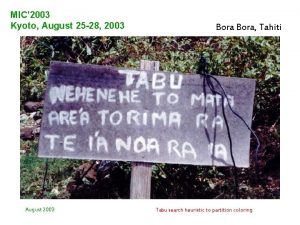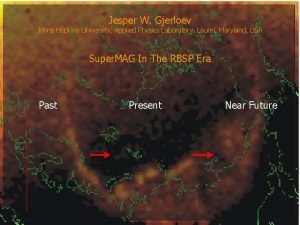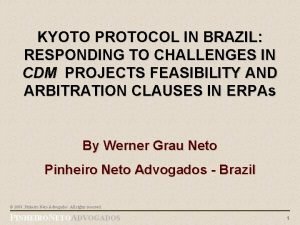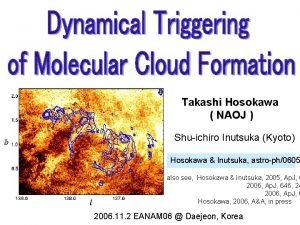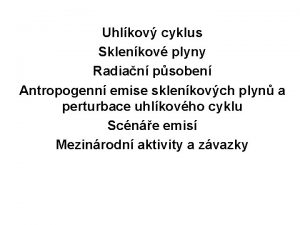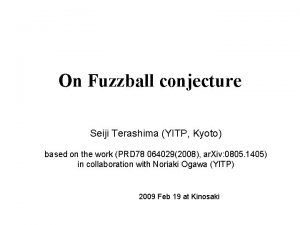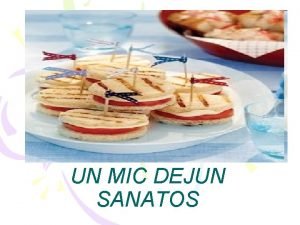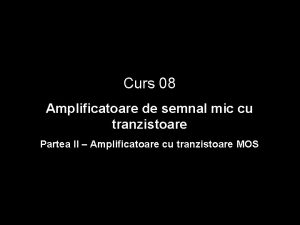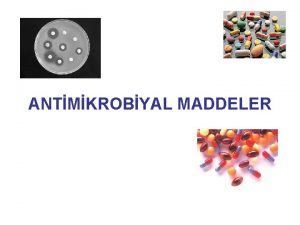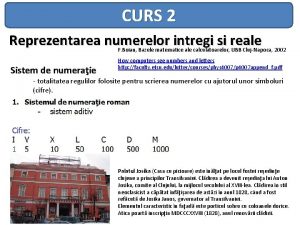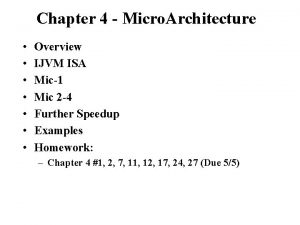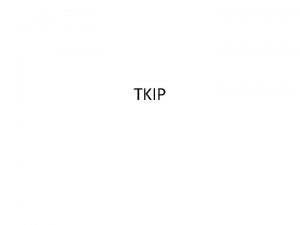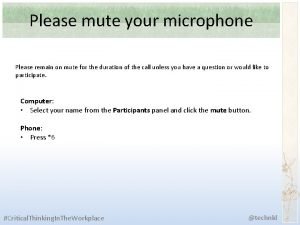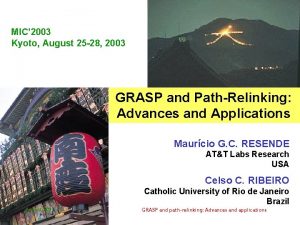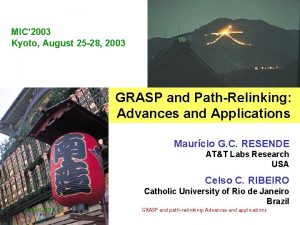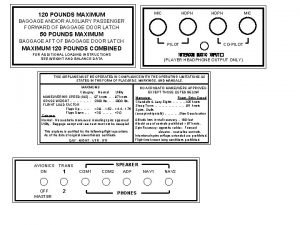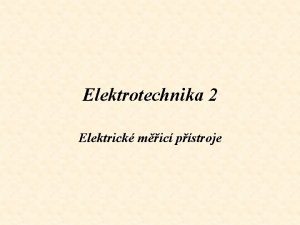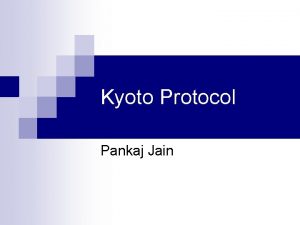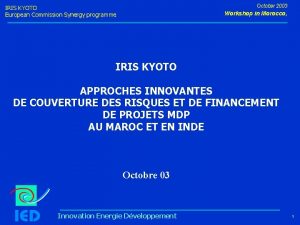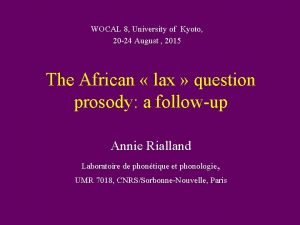MIC 2003 Kyoto August 25 28 2003 August




































- Slides: 36

MIC’ 2003 Kyoto, August 25 -28, 2003 August 2003 Bora, Tahiti Tabu search heuristic to partition coloring

MIC’ 2003 Kyoto, August 25 -28, 2003 A Tabu Search Heuristic for Partition Coloring with an Application to Routing and Wavelength Assignment August 2003 Tabu search heuristic to partition coloring

MIC’ 2003 Kyoto, August 25 -28, 2003 A Tabu Search Heuristic for Partition Coloring with an Application to Routing and Wavelength Assignment Thiago NORONHA Celso C. RIBEIRO Catholic University of Rio de Janeiro Brazil Tabu search heuristic for partition coloring

Introduction • The partition coloring problem (PCP) • Routing and wavelength assignment in alloptical networks (RWA) • Algorithms for PCP: construction, LS, tabu search • Computational results • Application: static lightpath establishment • Conclusions 4 August 2003 Tabu search heuristic to partition coloring

Partition coloring problem (PCP) • Graph G = (V, E) with vertex set partitioned into k disjoint subsets: V = V 1 V 2 . . . Vp • PCP consists in coloring exactly one node in each subset Vi , such that every two adjacent colored nodes have different colors. • Objective: minimize the number of colors used. August 2003 5 Tabu search heuristic to partition coloring

Partition coloring problem 1 1 2 6 0 4 7 2 6 3 4 6 4 0 0 5 2 2 6 3 August 2003 6 6 3 Tabu search heuristic to partition coloring

Routing and wavelength assignment in circuit-switched WDM all-optical networks • Different signals can be simultaneously transmitted in a fiber, using different wavelengths: – Wavelength Division Multiplexing • Connections (between origin-destination pairs) are established by lightpaths. • To establish a lightpath consists in determining: – a route August– 2003 a wavelength 7 Tabu search heuristic to partition coloring

Routing and wavelength assignment in circuit-switched WDM all-optical networks • Each signal can be switched optically at intermediate nodes in the network. • No wavelength conversion is possible. • Lightpaths sharing a common link are not allowed to use the same wavelength. • Traffic assumptions: Yoo & Banerjee (1997) – static lightpath establishment – dynamic lightpath establishment (O-D pairs are not known beforehand) August 2003 8 Tabu search heuristic to partition coloring

Routing and wavelength assignment in circuit-switched WDM all-optical networks • Static lightpath establishment (SLE) without wavelength conversion: – Minimize the total number of used wavelengths – Other objective functions may also consider the load in the most loaded link, the total number of optical switches (total length), etc. August 2003 9 Tabu search heuristic to partition coloring

Routing and wavelength assignment in circuit-switched WDM all-optical networks Optical network From SLE to PCP Lightpaths: A D B E C F Shortest path routing: three wavelengths are needed August 2003 10 Tabu search heuristic to partition coloring

Routing and wavelength assignment in circuit-switched WDM all-optical networks Optical network From SLE to PCP Lightpaths: A D B E C F 2 -shortest path routing August 2003 11 Tabu search heuristic to partition coloring

Routing and wavelength assignment in circuit-switched WDM all-optical networks Optical network From SLE to PCP Lightpaths: A D B E C F 2 -shortest path routing: only two wavelengths are needed! August 2003 12 Tabu search heuristic to partition coloring

Algorithms for PCP: Greedy heuristics • Onestep Largest First • Onestep Smallest Last • Onestep Color Degree (onestep. CD) – best in literature: Li & Simha (2000) • Twostep Largest First • Twostep Smallest Last • Twostep Color Degree August 2003 13 Tabu search heuristic to partition coloring

Algorithms for PCP: Onestep. CD 1. Remove all edges whose vertices are in same group. 2. Find the vertex with minimal color-degree for each uncolored group. 3. Among these vertices, find that with the largest color-degree. 4. Assign to this vertex the smallest available color and remove all other vertices in the same group. 5. Repeat the above steps until all groups are colored. 14 August 2003 Tabu search heuristic to partition coloring

Algorithms for PCP: Onestep. CD • Color degree: number of colored neighbors Uncolored degree: number of uncolored neighbors CD: 0 UD: 4 CD: 0 UD: 3 CD: 01 UD: 20 August 2003 15 Tabu search heuristic to partition coloring

Algorithms for PCP: Local search (1/2) • First, LS-PCP converts a feasible solution with C colors into an infeasible solution with C-1 colors; next, it attempts to restore solution feasibility. • The local search procedure investigates the subsets whose colored node is involved in a coloring conflict. • LS-PCP searches within each subset for a node that can be colored or recolored so as to reduce the overall number of coloring conflicts. August 2003 16 Tabu search heuristic to partition coloring

Algorithms for PCP: Local search (2/2) • In case such a node exists, the algorithm moves to a new solution. Otherwise, another subset is randomly chosen and investigated. • If a feasible solution with C-1 colors is found, the feasibility of this coloring is destroyed another coloring using C-2 colors is sought. • LS-PCP stops when the number of coloring conflicts cannot be reduced and the solution is still infeasible. August 2003 17 Tabu search heuristic to partition coloring

Algorithms for PCP: Local search August 2003 18 Tabu search heuristic to partition coloring

Algorithms for PCP: Tabu search • Simple short-term memory strategy: TS-PCP • Initial solutions: Onestep. CD • Local search strategy: LS-PCP – move: pair (node, color) • Tabu tenure: randomly in U[C/4, 3 C/4] • Aspiration criterion: improve best • Stopping criterion: C. P. 10 iterations without finding a feasible solution, where C = number of colors and P = number of subsets in the partition August 2003 19 Tabu search heuristic to partition coloring

Computational results • Random instances: – eight PCP instances generated from graph coloring instances DJSC-250. 5 and DJSC-500. 5 Aragon, Johnson, Mc. Geoch & C. Schevon (1991) • nodes in original instance are replicated (2 x, 3 x, 4 x) • edges are additioned with density 0. 5 • one subset for each original node • Computational experiments: Pentium IV 2. 0 GHz August 2003 20 Tabu search heuristic to partition coloring

Computational results Average results: construction, local search, tabu search Instance Onestep. C Local search Tabu search D nodes colors % red. DSJC-250. 51 DSJC-250. 52 250 41. 7 40. 6 3 29. 6 29 500 40. 4 38. 1 6 25. 8 36 DSJC-250. 53 DSJC-250. 54 750 38. 8 35. 6 8 24. 0 38 1000 38. 3 34. 7 9 23. 0 40 69. 3 3 6% 52. 635%26 DSJC-500. 5 August 2003 1 500 21 71. 2 Tabu search heuristic to partition coloring

Computational results Tabu search: solution values and times (10 runs) Colors Time (s) Instance DSJC-250. 51 DSJC-250. 52 DSJC-250. 53 DSJC-250. 54 DSJC-500. 51 August 2003 DSJC-500. 5 - best average worst 29 29. 6 30 6. 7 21. 4 25 25. 8 26 11. 7 62. 4 24 Robust! 24. 0 24 35. 2 164. 7 23 23. 0 23 65. 3 300. 8 52 52. 6 53 41. 9 197. 2 22 to best total Tabu search heuristic to partition coloring

Computational results Random instances: varying the number of subsets August 2003 23 Tabu search heuristic to partition coloring

Computational results Random instances: varying the graph density August 2003 24 Tabu search heuristic to partition coloring

Time-to-target-value plots • Select an instance and a target value: – Perform 200 runs using different seeds. – Stop when a solution value at least as good as the target is found. – For each run, measure the time-to-target-value. – Plot the probabilities of finding a solution at least as good as the target value within some computation time. • Plots can illustrate algorithm robustness and are very useful for comparisons based on the probability distribution of the time-to-targetvalue search heuristic to partition coloring – Aiex, Resende 25 & Ribeiro. Tabu (2002) August 2003

Time-to-target-value plots Instance DSJC-250. 5 -4 August 2003 26 Tabu search heuristic to partition coloring

Static Lightpath Establishment • Possible routing algorithms: – k-shortest paths – Path stripping: solves LP relaxation and builds progressively longer shortest routes using edges in the fractional solution. Banerjee & Mukherjee (1995) – Greedy-EDP-RWA: multistart construction using random permutations (greedy max edge-disjoint paths routing), too many restarts are needed. Manohar, Manjunath & Shevgaonkar (2002) August 2003 27 Tabu search heuristic to partition coloring

Application: SLE • Comparison: – n-Greedy-EDP-RWA vs. . –. . . two routing iterations of Greedy-EDP-RWA followed by partition coloring using TS-PCP • Both algorithms stop when a target solution value is found: – Target is the optimal value of the LP relaxation of the IP formulation without optical continuity constraints. August 2003 28 Tabu search heuristic to partition coloring

Application: SLE instance #1: 14 nodes, 21 links, and 182 connections August 2003 29 Tabu search heuristic to partition coloring

Application: SLE instance #1: target = 13 (optimal) August 2003 30 Tabu search heuristic to partition coloring

Application: SLE instance #2: 27 nodes, 70 links, and 702 connections August 2003 31 Tabu search heuristic to partition coloring

Application: SLE instance #2: target = 24 (optimal) August 2003 32 Tabu search heuristic to partition coloring

Conclusions • We proposed a local search procedure and a tabu search heuristic for partition coloring. • TS-PCP is able to significantly improve the solutions obtained by Onestep. CD. • TS-PCP together with a routing algorithm can be successfully used to solve SLE in RWA. • Future work will consider other routing algorithms to be used with TS-PCP to solve SLE in practical applications. August 2003 33 Tabu search heuristic to partition coloring

Slides and publications • Slides of this talk can be downloaded from: http: //www. inf. puc-rio/~celso/talks • Paper will be soon available at: http: //www. inf. pucrio. br/~celso/publicacoes August 2003 34 Tabu search heuristic to partition coloring

IV Workshop on Efficient and Experimental Algorithms Búzios (Brazil), May 25 to 28, 2004 Announcements • IV Workshop on Efficient and Experimental Algorithms Búzios (Brazil), May 25 to 28, 2004 August 2003 35 Tabu search heuristic to partition coloring

XIX International Symposium on Mathematical Programming Rio de Janeiro (Brazil), July 2006 August 2003 Tabu search heuristic to partition coloring
 282003 color
282003 color Menguin kyoto
Menguin kyoto Kyoto protocol brazil
Kyoto protocol brazil Kyoto treaty apush
Kyoto treaty apush Kyoto protocol reference manual
Kyoto protocol reference manual Mappa concettuale protocollo di kyoto
Mappa concettuale protocollo di kyoto Prtocolo de kyoto
Prtocolo de kyoto Combustivels
Combustivels Kyoto protocol
Kyoto protocol Kyoto
Kyoto Kyoto protocol
Kyoto protocol Kyoto protocol objectives
Kyoto protocol objectives Protocolo de kyoto
Protocolo de kyoto Yitp kyoto
Yitp kyoto Kyoto university vpn
Kyoto university vpn Geofon mic
Geofon mic T/mic
T/mic Microphone adalah
Microphone adalah Mic dejun sanatos cu ovaz in 6 variante
Mic dejun sanatos cu ovaz in 6 variante Punct static de functionare tranzistor
Punct static de functionare tranzistor Glikopeptidler
Glikopeptidler T/mic
T/mic Mic and mbc
Mic and mbc Mic next generation sequencing
Mic next generation sequencing Boian ubb
Boian ubb Dihorul patat
Dihorul patat Uscg mic
Uscg mic Mic gate pass office
Mic gate pass office Program mic
Program mic Cand sunt mic atunci sunt mare
Cand sunt mic atunci sunt mare Mic biologie
Mic biologie Ijvm multiplication
Ijvm multiplication Am un brâu vărgat de cer spânzurat
Am un brâu vărgat de cer spânzurat La trame mic
La trame mic Temporary key integrity protocol
Temporary key integrity protocol Microbiology
Microbiology Please keep your mic muted
Please keep your mic muted
